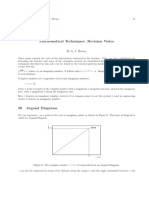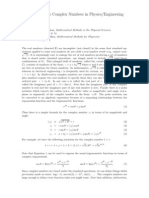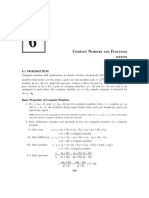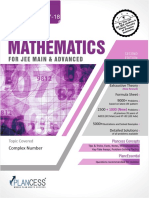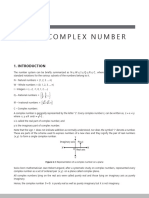0 ratings0% found this document useful (0 votes)
40 viewsNotes Advanced Math 1
This document provides a summary of mathematical operations involving complex numbers. It includes:
1) Definitions of complex numbers and their different forms including rectangular, trigonometric, polar, and exponential forms.
2) Operations involving complex numbers such as addition, subtraction, multiplication, division, raising to exponents, and taking roots.
3) Trigonometric functions, inverse trigonometric functions, hyperbolic functions, and inverse hyperbolic functions applied to complex numbers.
Uploaded by
b7xyxbfczvCopyright
© © All Rights Reserved
Available Formats
Download as PDF, TXT or read online on Scribd
0 ratings0% found this document useful (0 votes)
40 viewsNotes Advanced Math 1
This document provides a summary of mathematical operations involving complex numbers. It includes:
1) Definitions of complex numbers and their different forms including rectangular, trigonometric, polar, and exponential forms.
2) Operations involving complex numbers such as addition, subtraction, multiplication, division, raising to exponents, and taking roots.
3) Trigonometric functions, inverse trigonometric functions, hyperbolic functions, and inverse hyperbolic functions applied to complex numbers.
Uploaded by
b7xyxbfczvCopyright
© © All Rights Reserved
Available Formats
Download as PDF, TXT or read online on Scribd
You are on page 1/ 1
EXCEL REVIEW CENTER ENGINEERING MATHEMATICS
09173239235 | 09176239235 Advanced Math 1
my.excelreviewer.com
Complex Numbers MATHEMATICAL 7. Exponential and Trigonometric
A complex number is any number that OPERATIONS OF Functions of a Complex Number
can be expressed in the standard form a + COMPLEX NUMBERS
bi or a + jb. The value “i” or “j” is the Excel Review Center ej = cos + jsin
imaginary unit or number. It is equal to
1. Addition and Subtraction of Complex e− j = cos − jsin
−1 .
Numbers
Different Forms of sin =
ej − e− j
( a1 + jb1 ) + ( a2 + jb2 ) = (a1 + a2 ) + j(b1 + b2 ) 2
Complex Numbers ej + e− j
( a1 + jb1 ) − ( a2 + jb2 ) = (a1 − a2 ) + j(b1 − b2 ) cos =
1. Rectangular Form / Standard Form 2
2. Multiplication of Complex Numbers 8. Hyperbolic Functions of Complex
z = a +dsjb
V= Number
dt Use the polar form
where:
a = real part e − e−
sinh =
b = imaginary part ( r1 1 )( r2 2 ) = r1 r2 ( 1 + 2 ) 2
e + e−
If the real part a = 0, the z = jb. It is cosh =
2
called a pure imaginary number. 3. Division of Complex Numbers
2. Trigonometric Form Use the polar form Note:
sinh
z = rcos + jrsin tanh =
r1 1 r1 cosh
z = rcis = ( 1 + 2 )
r2 2 r2 cosh
coth =
Excel Review Center sinh
3. Polar Form 1
4. Complex Numbers raised to sech =
exponent “n” cosh
z = r Excel Review Center
1
csch =
where: Use the polar form sinh
r = modulus or absolute value
θ = argument or amplitude (in °) ( r )
n
= r n (n) 9. Inverse Trigonometric Functions
of Complex Numbers
F = kx
( )
Imaginary axis
5. nth root of a Complex Number
arcsinz = − jln jz 1 − z2
arccosz = − jln ( z z −1)
r Excel Review Center Use the polar form 2
b
+ k(360o )
( r)
1/n
Real axis = r1/n − j 1 + jz
a
n arctanz = ln
2 1 − jz
where:
r = a2 + b2 k = 0, first root or principal root
k = 1, second root 10. Inverse Hyperbolic Functions of
Complex Numbers
b k = 2, third root
= tan −1 k = n – 1, nth root
a
dy dx 6. Logarithm of a Complex Number (
arcsinhz = ln z z2 + 1 )
= − dy
arccoshz = ln ( z −1)
4. dx Form
Exponential
t g z2
Use the trigonometric form
z = rej 1 1+z
arctanhz = ln
lnz = rej = lnr + lnej 2 1 − z
where: lnz = lnr + j
θ = argument in radians Excel Review Center
Excel Review Center
You might also like
- Test Bank For Calculate With Confidence 1st Canadian Edition by Morris100% (40)Test Bank For Calculate With Confidence 1st Canadian Edition by Morris4 pages
- Mathematical Techniques: Revision Notes: DR A. J. BevanNo ratings yetMathematical Techniques: Revision Notes: DR A. J. Bevan8 pages
- Complex Numbers and Linear Algebra Lecture NotesNo ratings yetComplex Numbers and Linear Algebra Lecture Notes3 pages
- ≥ γ/α - there are two real roots < γ/α, then we are faced withNo ratings yet≥ γ/α - there are two real roots < γ/α, then we are faced with18 pages
- Practice Problems Exam 1, Spring 2018 Solutions: 1. Complex ArithmeticNo ratings yetPractice Problems Exam 1, Spring 2018 Solutions: 1. Complex Arithmetic10 pages
- Unit 4 - Mathematics II - WWW - Rgpvnotes.inNo ratings yetUnit 4 - Mathematics II - WWW - Rgpvnotes.in19 pages
- Engineering Mathematics 2A (Scee08009) : Refresher SheetNo ratings yetEngineering Mathematics 2A (Scee08009) : Refresher Sheet2 pages
- MATH 141, Tricks With Complex Numbers: Prof. Jonathan Rosenberg Fall Semester, 2012No ratings yetMATH 141, Tricks With Complex Numbers: Prof. Jonathan Rosenberg Fall Semester, 20122 pages
- Math3_Ch04_Complex Variable Spring 24-25No ratings yetMath3_Ch04_Complex Variable Spring 24-2514 pages
- Complex Numbers and Polynomials: Mats BodinNo ratings yetComplex Numbers and Polynomials: Mats Bodin43 pages
- Engineering mathematics Subject Lecture: ثراح يلع Stage: Second - A Subject: Complex Numbers لهنم رامع دمحمNo ratings yetEngineering mathematics Subject Lecture: ثراح يلع Stage: Second - A Subject: Complex Numbers لهنم رامع دمحم17 pages
- Math Formulas Book For JEE MAIN - Advanced - D.T PDFNo ratings yetMath Formulas Book For JEE MAIN - Advanced - D.T PDF41 pages
- Battery Eis Mathematics - Electrochemistry An50 1No ratings yetBattery Eis Mathematics - Electrochemistry An50 15 pages
- Dunman High School Mid-Year Examination Year 4 DHP: Mathematics 2No ratings yetDunman High School Mid-Year Examination Year 4 DHP: Mathematics 211 pages
- Informal Lecture Notes For Complex AnalysisNo ratings yetInformal Lecture Notes For Complex Analysis21 pages
- Complex Numbers (Trigonometry) Mathematics Question BankFrom EverandComplex Numbers (Trigonometry) Mathematics Question BankNo ratings yet
- Trigonometric Ratios to Transformations (Trigonometry) Mathematics E-Book For Public ExamsFrom EverandTrigonometric Ratios to Transformations (Trigonometry) Mathematics E-Book For Public Exams5/5 (1)
- Let's Practise: Maths Workbook Coursebook 7From EverandLet's Practise: Maths Workbook Coursebook 7No ratings yet
- Week 007 Calculus I - Logarithmic DifferentiationNo ratings yetWeek 007 Calculus I - Logarithmic Differentiation2 pages
- AA SL Topic 9 Exponential and LogarithmnsNo ratings yetAA SL Topic 9 Exponential and Logarithmns19 pages
- Integrated III Fractional Exponents Sub Work 1-10No ratings yetIntegrated III Fractional Exponents Sub Work 1-103 pages
- Multiplying and Dividing Rational ExpressionsNo ratings yetMultiplying and Dividing Rational Expressions19 pages
- Fractions Decimals and Percentages - Practice BookletNo ratings yetFractions Decimals and Percentages - Practice Booklet11 pages
- Module 3: Lntegration of Exponential and Natural LogarithmNo ratings yetModule 3: Lntegration of Exponential and Natural Logarithm21 pages
- Math - Gr6 - Q1 - Module 02-L1 - Multiplying-Simple-Fractions-and-Mixed-FractionsNo ratings yetMath - Gr6 - Q1 - Module 02-L1 - Multiplying-Simple-Fractions-and-Mixed-Fractions16 pages
- DLP of Addition and Subtraction of Rational Algebraic Expression100% (1)DLP of Addition and Subtraction of Rational Algebraic Expression11 pages
- Section 6.3 Extra Practice: Wherever Applicable, State The Non-Permissible Values For The VariablesNo ratings yetSection 6.3 Extra Practice: Wherever Applicable, State The Non-Permissible Values For The Variables1 page
- Laws of Logarithms - Laws of Logarithms and Exponents - Higher Maths Revision - BBC BitesizeNo ratings yetLaws of Logarithms - Laws of Logarithms and Exponents - Higher Maths Revision - BBC Bitesize1 page
- Number Series Quant Questions and Answers PDF by Ambitious BabaNo ratings yetNumber Series Quant Questions and Answers PDF by Ambitious Baba10 pages
- 3 2 Logarithmic Functions and Their GraphsNo ratings yet3 2 Logarithmic Functions and Their Graphs33 pages
- FHMM 1114 General Mathematics I: Lecture Chapter 1No ratings yetFHMM 1114 General Mathematics I: Lecture Chapter 135 pages


